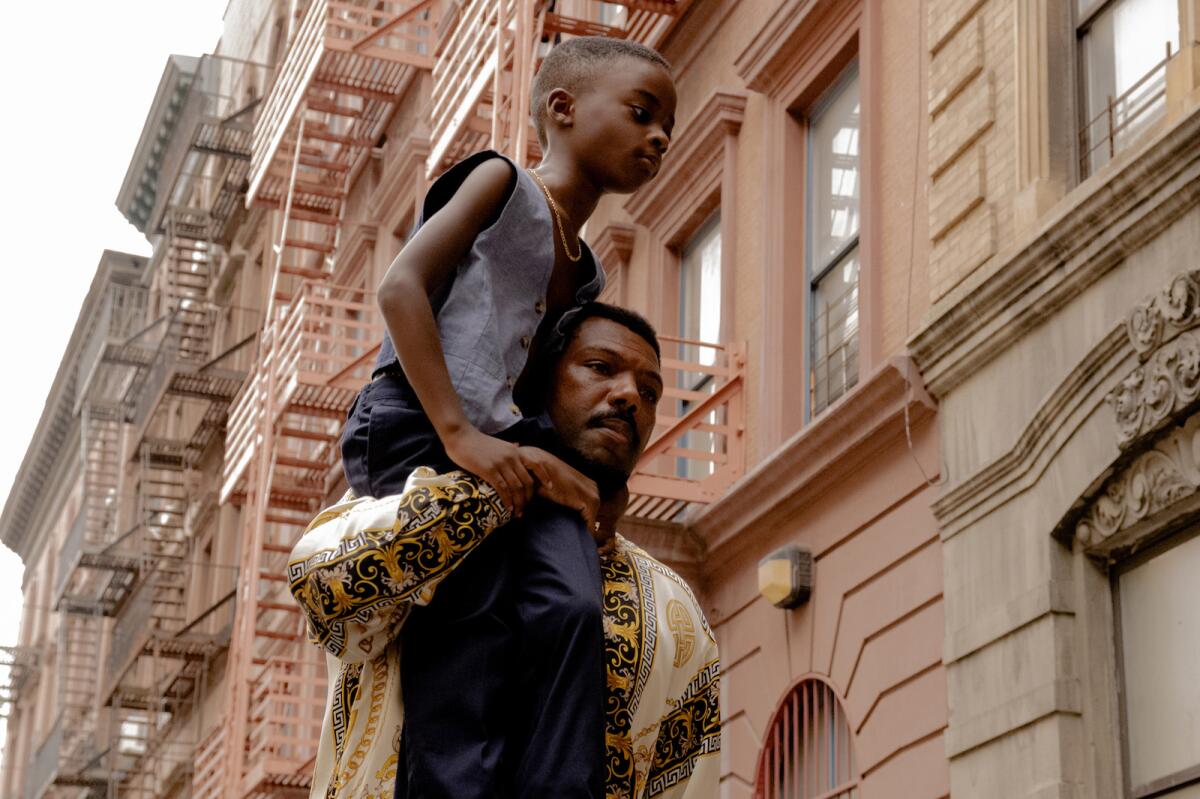Review: ‘A Thousand and One’ offers a gritty New York story of survival

- Share via
Mothers are often the keepers of secrets, borne from a primal instinct for survival. But secrets fester, grow bigger and inevitably burst with the resonance of truth, as they do in “A Thousand and One,” the debut feature of writer/director A.V. Rockwell. The film, which won the U.S. dramatic grand jury prize at the 2023 Sundance Film Festival, casts the harrowing story of a mother and her son against the backdrop of a gentrifying Harlem.
“A Thousand and One” proves to be a showcase for multihyphenate star and Harlem native Teyana Taylor, who brings to her astonishing performance the coiled physicality of a panther ready to pounce. Her character, Inez, is on the offense as her only form of defense, a stance and ethos that never wavers throughout the years we follow her.
Sweeping aerial shots set to soulful strings introduce us to the iconography of New York City: the Empire State Building, Central Park and, of course, Rikers Island, holding New York City’s largest jail. It’s 1994 and we meet the incarcerated Inez in a tender moment: gently applying makeup to another female inmate. Soon, she’s released back on the streets of Harlem, hawking her services as a hairstylist and desperately trying to stay out of the shelter.
Her swift, confident movements are captured in snippets of grainy, handheld images. Cinematographer Eric K. Yue also employs pans and zooms that harken back to the New Hollywood films of the 1970s, placing this film in a long lineage of gritty New York City indie filmmaking.

A wrinkle in Inez’s survival story manifests, a wrinkle that soon becomes her purpose and her driving force: her young boy Terry (the wonderfully instinctive Aaron Kingsley Adetola), who is living in foster care. When an accident lands him in the hospital, Inez works her way back into his heart with Power Rangers toys and quality time. She asks if he’d like to come stay with her for a bit — a son should live with his mother, after all. They crash at a friend’s, and eventually land their own spot in a brownstone, Inez doing hair in her room for cash. Since she’s essentially abducted him from the government, she pays a guy for a fake birth certificate for Terry, who goes by Darryl at school.
The story of Terry and Inez and, later, Lucky (William Catlett), her boyfriend who becomes a father figure for Terry, is a simple one. But the lived-in quality of the material makes this story feel so real, and almost stranger than fiction at times. It’s not a true story, but it comes from a place of truth, and in her writing and direction Rockwell brings a hyper-specificity to the film, whether in the way young Terry passes the time alone at home, or in the fumbling courtships he undertakes as a teen (played by Aven Courtney). It’s in the speeches that Lucky and Inez deliver to Terry about striving for more beyond what they experienced, which manage to never seem phony or labored.
The film is utterly absorbing, anchored by the unpredictable performance of Taylor, playing a hopelessly complicated, but deeply caring woman. When faced with dire circumstances, she survives, then dares to imagine a life for Terry beyond the cycle she’s experienced, forging a family unit she never had. Through sheer willpower, she gets them to a point where she can see his bright future; yet when 17-year-old Terry (a remarkable Josiah Cross) finds himself inadvertently repeating some of his mother’s actions in 2005, it seems a grim kind of fate.
Filmmaker A.V. Rockwell and star Teyana Taylor open up about their ‘heartbreak letter’ and Sundance prizewinner ‘A Thousand and One,’ opening Friday.
There are larger forces at play beyond the decisions Inez made out of fear and anxiety when she was 22 and fresh out of jail. The home she’s made starts to crumble in tandem with the fracturing of their family unit. Their new landlord puts on a helpful face and offers to fix things, but underneath his smiling exterior, seems to want them gone, the home eventually becoming inhospitable when Terry needs it the most.
Rockwell evolves the film’s style over the years, using the ghostly aerial shots of the city as a stylistic motif and device to situate the viewer and signify time bleeding into the atmosphere. During a climactic conversation between Terry and Inez, all color has been drained from the image, the two pictured in stark contrast to the white walls. All that is left between them is the messy, complicated truth, though the shades of gray are thrown into shocking black and white.
“A Thousand and One” is a fascinating portrait of the maternal, feminine instinct caught in an unforgiving world. Taylor’s Inez, possessed of a hard-bitten skill for self-preservation, stays one step ahead, constantly moving forward, a soft shred of hope her only cold comfort.
Katie Walsh is Tribune News Service film critic.
'A Thousand and One'
Rated: R, for language
Running time: 1 hour, 57 minutes
Playing: In general release
More to Read
Only good movies
Get the Indie Focus newsletter, Mark Olsen's weekly guide to the world of cinema.
You may occasionally receive promotional content from the Los Angeles Times.











